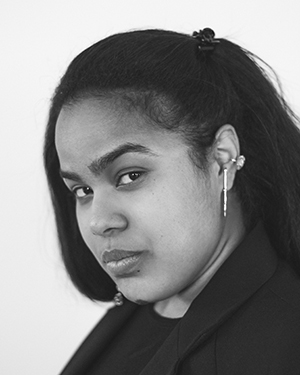Chris Blakeslee has experience at Athleta and Alo Yoga. Kendra Scott will remain on board as executive chair and chief visionary officer.
BIPOC Designers Have Something to Say to the Industry
An open letter from a group of black, indigenous, and people of color jewelry designers calls for more support, education and equity.

Authored by New York-based jewelry designer Angely Martinez, the idea for the letter took seed in the weeks following George Floyd’s murder at the hands of Minneapolis police, when protests spread worldwide and forced both businesses and individuals to have conversations about racial inequities.
In the jewelry industry, tensions flared and boiled over during this period, with companies and individuals being boycotted and “canceled”—internet parlance for a collective withdrawal of support, usually of large companies or celebrities—on social media.

Martinez and designer Jules Kim, founder of Bijules and the Bijules Incubator, decided together the social media battles weren’t going to result in any formative change.
“What happens there [on social media], as we’ve seen, regardless of what the call-out might be, there’s constant back and forth, there’s unregulated conversations, and no call to action can be organized,” Kim observed.
So Martinez reached out to her fellow BIPOC designers and started writing.
She pulled their requests, desires and values into a single document, ultimately giving BIPOC designers a unified, collective voice about the change they want to see and how it can happen.
“We’re not asking for handouts,” Martinez emphasized. “This a very talented group of individuals. Nothing has been given to us. Everything we have, we have worked for and will continue to work for.”
Signed by a total of 29 BIPOC designers based in the U.S. and U.K., the letter lays out the commitments that members of the jewelry industry, from the largest corporations to the smallest companies, can and need to make to ensure long-term equity.
They include:
— Investing in education for BIPOC designers at all levels;
— Increasing the representation of BIPOC-owned businesses in retail shelf space;
— Employing people of color in classrooms, retail sales floors, trade show booths, marketing and merchandising positions, etc.;
— Increasing the presence of BIPOC on committees and boards;
— Continuing to find and support BIPOC designers through media interviews, articles, studio visits, social media, etc.;
— Acknowledging the origins of inspiration from BIPOC cultures, traditions, and historical objects; and
— Supporting the creation of a BIPOC Jewelers Association to protect the designers’ work and future.
Planned as a 501(c)6, Martinez said the association primarily will be led by BIPOC designers, with support from some non-BIPOC members of the industry, and will be for all genders.
“What we’ve been talking a lot about is outreach to high school students,” Martinez said.
She expects the association will take about six to nine months to get off the ground.
In the meantime, Kim said, there’s no need to wait for the nonprofit’s launch in order to act, as there is “a really beautiful roster” of BIPOC designers “itching to create and have their voices heard.”
Specific calls to action outlined in the letter include the following:
— Acting with grace, resolve and leadership, not defensiveness:
— Hosting of ongoing conversations pertaining to equality, equity and opportunity for BIPOC designers;
— Increasing access to raw materials and bench time, pricing strategies, merchandising tools, business marketing and strategy, responsible sourcing and sustainability;
— Including BIPOC into leadership and curatorial positions and establishing funds to create new institutions and opportunities for BIPOC;
— Recognizing racism within, acknowledging systemic racism and working to eliminate it;
— Increasing representation in editorial in industry-specific media outlets; and
— Recognition from major organizations in the industry, and a commitment to these actions.
To read the letter in its entirety or sign it to become more involved, click here.
For more information on the designers and their letter, or to get involved with or stay informed about these efforts, email jewelryindustrytaskforce@gmail.com.
The Latest

The credit card companies’ surveys examined where consumers shopped, what they bought, and what they valued this holiday season.

Kimberly Miller has been promoted to the role.

How Jewelers of America’s 20 Under 40 are leading to ensure a brighter future for the jewelry industry.

The “Serenity” charm set with 13 opals is a modern amulet offering protection, guidance, and intention, the brand said.


“Bridgerton” actresses Hannah Dodd and Claudia Jessie star in the brand’s “Rules to Love By” campaign.

Founded by jeweler and sculptor Ana Khouri, the brand is “expanding the boundaries of what high jewelry can be.”

Roseco’s 704-page catalog showcases new lab-grown diamonds, findings, tools & more—available in print or interactive digital editions.

The jewelry manufacturer and supplier is going with a fiery shade it says symbolizes power and transformation.

The singer-songwriter will make her debut as the French luxury brand’s new ambassador in a campaign for its “Coco Crush” jewelry line.

The nonprofit’s new president and CEO, Annie Doresca, also began her role this month.

As the shopping mall model evolves and online retail grows, Smith shares his predictions for the future of physical stores.

The trade show is slated for Jan. 31-Feb. 2 at The Lighthouse in New York City's Chelsea neighborhood.

January’s birthstone comes in a rainbow of colors, from the traditional red to orange, purple, and green.

The annual report highlights how it supported communities in areas where natural diamonds are mined, crafted, and sold.

Footage of a fight breaking out in the NYC Diamond District was viewed millions of times on Instagram and Facebook.

The supplier has a curated list of must-have tools for jewelers doing in-house custom work this year.

The Signet Jewelers-owned store, which turned 100 last year, calls its new concept stores “The Edit.”

Linda Coutu is rejoining the precious metals provider as its director of sales.

The governing board welcomed two new members, Claire Scragg and Susan Eisen.

Sparkle with festive diamond jewelry as we celebrate the beginning of 2026.

The master jeweler, Olympian, former senator, and Korean War veteran founded the brand Nighthorse Jewelry.

In its annual report, Pinterest noted an increase in searches for brooches, heirloom jewelry, and ‘80s luxury.

Executive Chairman Richard Baker will take over the role as rumors swirl that a bankruptcy filing is imminent for the troubled retailer.

Mohr had just retired in June after more than two decades as Couture’s retailer liaison.

Shekhar Shah of Real Gems Inc. will serve as president of the Indian Diamond & Colorstone Association in 2026.

This year’s good luck charm features the mythical horse Pegasus, and is our first Piece of the Week of the new year.



























